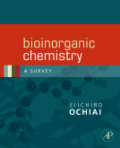
This is the study of the chemistry of living processes. Biochemistry has traditionally centered on the behavior of organic chemical compounds in water, theprinciple solvent in all cells. Organic compounds and water account for 99 percent of the matter in living systems. Some 20 inorganic elements are also essential for life, and they are found in similar amounts in most living systems.Bioinorganic Chemistry is essentially the border between inorganic chemistry and biology. The overall purpose of bioinorganic research is to study the relationship between inorganic metal ions such as copper and iron, and biologically specific macromolecules, experimentally as well as theoretically. The importance of inorganic chemistry in biology, especially metal ion coordination, hasgained considerable attention during the last decade.The discoveries of the roles of metal ions and metalloproteins in health and disease through genetic and biochemical studies have drawn the attention of both inorganic chemists andmolecular and cell biologists. Bioinorganic courses deal with the specific properties of metal ions as expressed in the functioning of biochemical systems,with the objective to deepen student insight into the chemical behaviour of metal ions in biological systems. Ochiai is generally considered the father of the discipline. When first published in 1977, the very successful first edition provided a clear and concise introduction to the brand new field of bioinorganic chemistry.This book: provides the streamlined coverage appropriate for one-semester courses or independent study, with all of the necessary but none ofthe excessive information; prepares readers to move to the next level of study (whether they continue on in the field or transition to medicine/industry); presents concepts through extensive four-color visuals, appealing to a range of learning styles; and, promotes critical thinking through open-ended questions throughout the narrative and at the end of each chapter. INDICE: Chapt. 0. Basics of Bio/ecosystems and Biochemistry, and Other Basic Concepts 0.1.Biosphere (Ecosystem) 0.1.1. Components of the biosphere-Living organisms 0.1.2. Bodily structure of living organisms 0.2. Cells, the Basic Functional Units of Living Organisms 0.3. Basic Biochemicals Essential to Life0.3.1. Carbohydrates 0.3.1.1. Monosasccharides 0.3.1.2. Polysaccharides and derivatives 0.3.2. Lipids 0.3.2.1. Fats and phospholipids 0.3.2.2. Steroids 0.3.3. Proteins and amino acids 0.3.3.1. Structures 0.3.3.2. Reactions – formation and hydrolysis of protein 0.3.4. Nucleotides, vitamins (coenzymes) and others 0.3.4.1. Coenzymes 0.3.4.2. Nucleotides 0.3.4.3. Other vitamins 0.3.4.4. Hormone, neurotransmitters and others 0.3.5. DNA/RNA (Polynucleotide) 0.3.5.1. Structures 0.3.5.2. Reactions 0.4. Types of Biochemical Reactions 0.4.1. Reactions of acid-base type 0.4.2. Reactions of oxidation-reduction type 0.4.2.1. Theidea of oxidation state 0.4.2.2. The oxidation state of ?C? in organic compounds and recognition of oxidation-reduction reactions 0.4.2.3. Other kinds of oxidation-reduction reactions 0.4.3. Free radical reactions 0.5. Transition State Theory of Reaction, and Enzyme Kinetics 0.5.1. Energy profile and transition state theory of reaction 0.5.2. Enzyme Kinetics 0.5.3. Enzyme reaction mechanism Chapt. 1. Distribution of Elements 1.1. Distribution of Elements in EarthCrust/Sea Water/Organisms 1.2. The Engines to Drive the Biochemical Cycling of the Elements 1.3. The Geochemical Cycling of Elements – Contribution by Biosphere 1.4. Historical Change in the Biogeochemical Cycling of Elements Chapt. 2. Biological Necessity for and the Behaviors of Inorganic Elements 2.1. Introduction 2.2..Inorganic Elements in Biological Systems 2.2.1. Inorganic elements involved at molecular level 2.2.2. Inorganic elements involved at cellular level 2.2.3. Inorganic elements involved at physiological level 2.2.4. Biological systems involved in the metabolism of inorganic elements 2.3. Why have Organisms Chosen Specific Elements for their Specific Needs Basic Rules 2.4. Behaviors of Inorganic Elements-1-Fundamentals of Coordination Chemistry 2.4.1. Coordination compounds or metal complexes 2.4.2. Ligand field theory-how the predominant structure is determined 2.4.3. Thermodynamic tendency to form coordination compounds 2.4.4. Chelate effects 2.4.5. Ligand substitution reactions 2.4.6. Oxidation-reduction and reduction potential 2.4.7. Kinetic factors including long-range electron transference 2.5. Behaviors of Inorganic Elements-2-Organometallic Chemistry 2.5.1. Metal carbonyls and 18 electron rule 2.5.2. Otherorganometallic compounds 2.5.3. Some special types of reactions involving organometallic compounds Chapt. 3. How Do Enzymes Work? 3.1. Enzymatic Enhancement of Reaction Rate – General Considerations 3.1.1. ?Transition state? theory 3.1.2. The ?Dynamic? effects 3.1.3. A Composite theory 3.2. Metalloenzymes and Metal-Activated Enzymes/Proteins Chapt. 4. Reactions of Acid-Base Type and Functions of Metal Cations 4.1. General Considerations 4.1.1. Different types (definitions) of acid-base 4.1.2. Enzymes catalyzing reactions of acid-base type 4.1.3. Acidity scale and acid character of metal cations – prominence of Zn(II) and Mg(II) 4.1.4. Kinetic factors 4.1.5. The enhancement of reaction by amino acid residues in protein 4.2. Mg(II)-dependent Enzymes 4.2.1. Rubisco (Ribulose1,5-bisphosphate carboxylase/oxygenase) 4.2.1. Pyruvate kinase 4.3. Zn(II)-dependent Enzymes 4.3.1. Carbonic anhydrase 4.3.2. Thermolysin, carboxypeptidase A and others 4.3.3. Leucine amonopeptidase 4.3.4. Alkaline phosphatase and purple-acid phosphatase 4.3.5. Alcohol dehydrogenase 4.4. Other Cation-dependent Enzymes 4.4.1. Aconitase, an iron-sulfur enzyme, and others 4.4.2. Arginase– a Mn enzyme 4.4.3. Urease and other Ni-enzymes 4.5. Structural Effects of Metal Ions 4.6. Metal Ions and Polynucleic Acids (DNA and RNA) 4.6.1. General characteristics of interactions of metal ions with polynucleotides 4.6.1.1. Effects on structures 4.6.1.2. Catalytic metal ions in DNA polymerases and nucleases 4.6.2. Gene regulation and metal ions 4.6.2. Ribozymes Chapt. 5. Reactionsof Oxidation-Reduction Type including Electron Transfer Processes 5.1. General Consideration 5.1.1. Reduction potential 5.1.1.1. Heme proteins and enzymes 5.1.1.2. Iron-sulfur proteins 5.1.1.3. Copper proteins 5.1.1.4. Molybdenum proteins/tungsten proteins 5.1.2. Kinetic factors – electron transfer between andin protein(s) 5.2. Iron Enzymes and Proteins 5.2.1. Cytochromes and iron-sulfur electron transfer proteins 5.2.2. Nitrate reductase and nitric oxide reductase 5.2.3. Horse radish peroxidase (HRP), catalase and cytochrome c peroxidase5.2.4. Hydrogenase 5.3. Copper Enzymes and Proteins 5.3.1. Blue copper proteins 5.3.2. Blue oxidases 5.3.3. Cytochrome c oxidase 5.3.4. Nitrite reductase and nitrous oxide reductase 5.3.5. Amine oxidases 5.3.6. Superoxide dismutase 5.4. Molybdenum Enzymes and Tungsten Enzymes 5.4.1. Xanthine oxidase and aldehyde oxidase 5.4.2. Sulfite oxidase and nitrate reductase (assimilatory) 5.4.3. DMSO reductase and nitrate reductase (respiratory)... etc.
- ISBN: 978-0-12-088756-9
- Editorial: Academic Press
- Encuadernacion: Rústica
- Páginas: 304
- Fecha Publicación: 01/08/2008
- Nº Volúmenes: 1
- Idioma: Inglés
